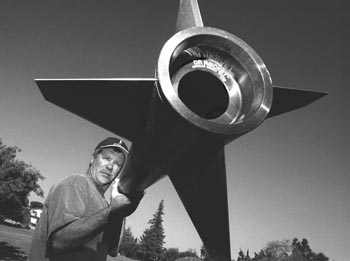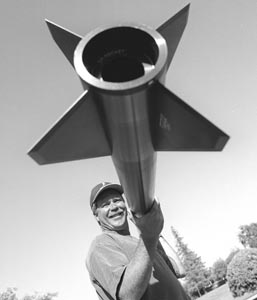![[Metroactive News&Issues]](/gifs/news468.gif)
![[Metroactive News&Issues]](/gifs/news468.gif)
[ Metro | Metroactive Central | Archives ]
Garage Rocket
Astro-Nut: Amateur rocket enthusiast Tom Rouse hopes to win a quarter-million-dollar prize by launching the first civilian rocket into space.
With no help from NASA, the Air Force or any other billion-dollar backers, a team of San Jose engineers is at work on the world's first homemade spacecraft.
By Jeff Kearns
ON AN OVERCAST Sunday afternoon in Almaden, one guy is mowing the lawn, another is washing his car. Two kids fight boredom by shooting hoops in the driveway of a ranch-style house. The scene couldn't be more normal. But in the garage of another typical-looking house, three men stand around a disassembled rocket on a wooden workbench, bent on making history.
Tom Rouse, a San Jose contractor, is hoping to lead a small team to launch the world's first civilian space shot. Rouse, 42, calls his project the Initial Civilian/Amateur Near Orbital mission, or ICANO. He's enlisted Ken Wada, an electronics engineer from Saratoga who designed and built the team's flight computer; a small rocket company in the Mojave Desert; and four Stanford grad students who built two small "parasatellites" that will go along for the ride.
If everything goes as planned, Rouse and the rest of his team will head up to a remote launch site two hours north of Fairbanks, Alaska, sometime in August. Their 30-foot rocket will break the sound barrier shortly after clearing the pad and cruise at Mach 8 for 24 seconds until it hits 100,000 feet. After that, it will coast through the thin layers of the upper atmosphere until it reaches its apogee somewhere around 160 miles and falls straight back to earth. The launch won't make it into orbit, but it will make it into space.
It will, that is, if the team can get through a web of government red tape; if the rocket doesn't turn into a "land shark" and cruise across the tundra on its side; if the altitude can be verified--there are a lot of "ifs."
The biggest "if," however, depends on the other 25 groups also trying to be the first team to launch successfully and claim the $250,000 CATS Prize, which will be awarded to the team that achieves Cheap Access To Space.
That prize was announced last November by a nonprofit advocacy group, the Space Frontiers Foundation. It's based on the same principles as the $25,000 Orteig Prize that Charles Lindbergh claimed after crossing the Atlantic in 1927.
The rules: designs must be original and produced without government or corporate involvement; launches must obtain permission from the government; and the flight's altitude must be verified.
As milestones go, it's not Sputnik or Apollo 11. But instead of spending a noticeable percentage of the GDP on a massive government project, Rouse is taking the guerrilla approach and trying to do it for about $60,000. Rouse started on the project shortly after the prize was announced, and he says he's going to be ready to fly a mere eight months later.
ICANO is contracting with a small company in Riverside County, Rocket Dyne (not affiliated with Rocketdyne, the Boeing subsidiary), which is building the rocket and casting the solid fuel boosters.
To Rocket Dyne's Mick Gilette, an amateur rocket builder, it's all pretty simple: "We're not reinventing the wheel," he says. "We're just cutting out the BS."
Astronomical Prizes
THE GOAL OF both the race and those running in it, however, isn't only to be the first to put a simple rocket into space. Rather, it's to put pressure on the folks at NASA.
David Anderman, who is administering the contest, says that to launch certain kinds of rockets without getting prosecuted means climbing a mountain of forms: "The paperwork you've got to fill out now may be an inch thick," he says. He and others complain that the government puts impossible controls on cheap, civilian projects, and that those only stifle development of innovative projects that could revolutionize space exploration and, eventually, travel and colonization.
These rocketeers--the 21st-century equivalent of barnstormers--hope that the CATS prize will start the entire aerospace industry's irreversible shift away from the current model, where a handful of monolithic entities do everything.
Anderman got the money from the nonprofit Foundation for the International Non-Governmental Development of Space, FINDS, by writing a grant proposal for $300,000. (For teams that don't hit the 120-mile mark, there's also a $50,000 consolation prize for 50 miles.)
It's not easy to keep track of who's leading the pack, Anderman says. "Rocket guys like to tell a lot of stories," he says. "Typically, the more grandiose their plan is, the less sophisticated they are and the less technologically competent."
There are a variety of homemade rockets in the race. One team plans to send its rocket up through the lower atmosphere in a balloon, then launch from there. Several teams have already been successful with launches up to five or seven miles, where commercial airline flights cruise, and one team from Texas has cleared only 20 feet.
Space advocates like Anderman see themselves as rebels trying to blow up the massive NASA Death Star. They probably wouldn't explain it the same way, but what most of them have in common is that they revile the agency's wasteful ways and narrow focus on small-minded, big-budget ideas like the shuttle.
"They're the most inefficient entity you could imagine," Anderman says. "Most of [NASA's] programs continue to exist just to keep the tax dollars flowing."
Alderman, who works as a contract negotiator, helped write the Commercial Launch Services Purchase Act of 1990. "It created the commercial launch industry of today," he boasts. "Up through the '80s, they were the only group that could launch into space. They were kicking and screaming when that one came out."
Garage Brand
THE FLIGHT COMPUTER running the ICANO mission looks like an overgrown RAM SIMM, measuring about 1 by 8 inches. It's run by two old 14MHz Intel chips, programmed by Wada. Also on the board is a tiny altimeter, about the size of a pea--the same kind found on Cessnas--and a tiny accelerometer that's commonly used as a trigger for airbags. An Ethernet jack on one end of the green circuit board plugs into Wada's laptop, which lets him program the rocket directly, or into the modem serving as the rocket's ground link.
It doesn't look like much, but Wada says it packs about as much processing power as the computer aboard the Gemini mission. Rouse has also donated his family's Handycam, which will look down out of the body of the rocket at a 30-degree angle and downlink the video through the flight computer.
Grad students from Stanford's Space Systems Development Lab are in the process of testing the two small para-satellites that are getting free rides on the rocket. Rouse approached Stanford last year with spare payload space, and Stanford jumped on the opportunity to team up with these garage-tech guys.
One of the ride-alongs is the Barnacle, built by Jeff Ota and Pascal Stang, which will give on-board electronics a second link to the ground. About a foot long by six inches wide, it will be testing off-the-shelf consumer electronics like the Motorola 68HC11. The chip is old and slow, but because it's easily programmable and was massively produced, it's commonly taught to electronics and engineering students. But like any silicon-based chip, it's also highly susceptible to the radiation that will bombard and most likely scramble the chip once it reaches space. If the special protective coating the students are working on keeps the chip running smoothly, the payoff will be for the large number of engineers trained on the chip who will be able program chips for satellites.
"A lot of commercial things, like capacitors, weren't made to withstand conditions like radiation, vacuum and heavy shaking. Capacitors have air inside, and they blow up in a vacuum, but we're buying this stuff from Radio Shack and Fry's," says Chris Kitts, who's working (along with Anthony Peña) on the second project: a Global Positioning System receiver. The GPS receiver, built and donated by Novatel, will track its own location and send the info down to Wada's laptop. It will also serve as a beacon for finding the rocket when it drops back to earth, presumably somewhere in northern Alaska. But perhaps its most important job will be to provide the verification the team needs to collect the prize.
Before the receiver could fly, however, the team had to get special permission from the government, which forbids anyone from operating a GPS receiver at speeds above Mach 2. Because GPS receivers are accurate to within a few feet anywhere on the globe, commercial models contain a shutoff that disables the unit when it detects that it's moving at more than twice the speed of sound--otherwise, the increasingly popular little gadgets would make perfect guidance systems for homemade ICBMs.
Rouse is also sending up several sheets of $3 Mars Explorer stamps, which he plans to auction off to obsessive philatelists if the mission succeeds.
What about the prize money? Rouse says that after paying off the costs (including the astronomical insurance policy), various team members will split part of the booty and $20,000 will go back to the lab at Stanford for future projects. The remainder will go toward nonprofit science programs, where he hopes the next bunch of kids may be dreaming up their own schemes.
That is, if he wins.
[ San Jose | Metroactive Central | Archives ]
![]()

Christopher Gardner No Such Thing as a Free Launch: San Jose resident Tom Rouse targets a $250,000 prize with his homemade rocket.
No Such Thing as a Free Launch: San Jose resident Tom Rouse targets a $250,000 prize with his homemade rocket.
From the July 2-8, 1998 issue of Metro.